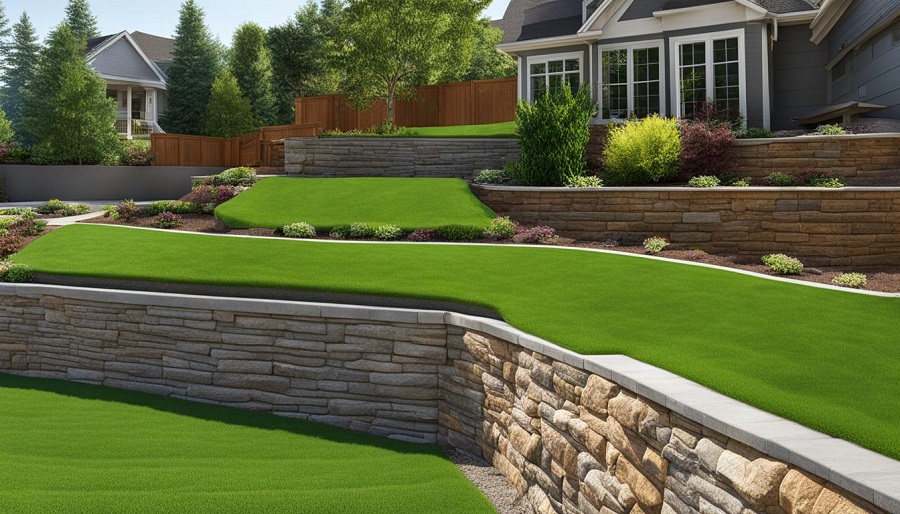Retaining walls aren’t just about holding back soil—they play a major role in shaping your yard, protecting your property, and adding beauty to outdoor spaces. But like any structure, they don’t last forever. Over time, you may notice leaning, cracking, or even sections collapsing. When this happens, homeowners are faced with a tough question: Should you repair your retaining wall, or is it better to replace it entirely?
Let’s discuss this in detail so you can make the best financial decision for your property.
Why Retaining Walls Fail in the First Place
Before deciding whether to repair or replace, it’s important to understand why retaining walls fail. Common causes include:
- Poor drainage: Water builds up behind the wall, creating hydrostatic pressure that pushes the structure forward.
- Soil movement: Expansive clay soil or poorly compacted backfill can shift, stressing the wall.
- Incorrect design or installation: Walls not built to handle the pressure of the slope often show problems within a few years.
- Material deterioration: Timber rots, concrete cracks, and stone can loosen over time.
Knowing the root cause of failure helps you determine whether a repair will hold up—or whether it’s just delaying the inevitable.
Signs Your Retaining Wall May Need Attention
How do you know when your retaining wall is in trouble? Watch for these warning signs:
- Cracks in the wall surface.
- Bulging or leaning outward.
- Separation between wall segments.
- Water pooling at the base.
- Soil erosion around or behind the wall.
Have you noticed any of these signs in your own yard? If so, it’s time to weigh your options.
The Case for Retaining Wall Repair
Sometimes a wall doesn’t need a full rebuild. Repairs can be a cost-effective solution if the damage is minor or localized.
When Repair Makes Sense
- Small cracks: Sealing or patching can prevent further water intrusion.
- Drainage issues: Installing new weep holes or drainage pipes can relieve pressure and extend the wall’s lifespan.
- Minor leaning: In some cases, reinforcement or tiebacks can stabilize a wall without rebuilding it.
- Material replacement: Replacing a few damaged blocks or stones is often easier than reconstructing the entire wall.
Advantages of Repair
- Lower upfront cost compared to replacement.
- Quicker turnaround time.
- Minimal disruption to your yard.
The Limitations of Repair
Repairs may extend the life of your wall but won’t always address underlying issues—especially if poor design or soil conditions are the root cause. In such cases, repairs are only temporary fixes.
The Case for Retaining Wall Replacement
Sometimes, no matter how much patching you do, a wall is simply beyond saving. Rebuilding ensures a fresh start with modern materials, proper design, and improved drainage.
When Replacement Is Necessary
- Severe leaning or bulging: Indicates structural failure that repairs can’t solve.
- Extensive cracking: Shows that pressure has exceeded the wall’s capacity.
- Rotten or decayed timber walls: Often better to rebuild with longer-lasting materials like concrete or stone.
- Repeated repairs: If you’re fixing the same issues over and over, it’s time to consider replacement.
Advantages of Replacement
- Long-term durability and peace of mind.
- Opportunity to upgrade to better materials.
- Improved design and drainage systems.
- Potential to enhance property value and curb appeal.
The Drawbacks of Replacement
- Higher upfront cost.
- Longer construction timeline.
- Requires more planning and potentially permits.
The Financial Side: Repair vs. Replacement
Money is usually the deciding factor. So, which option makes more financial sense?
Cost of Repair
Repairs can range from a few hundred to a few thousand dollars, depending on the severity of damage. For example, sealing cracks might cost little, while adding drainage or reinforcement could be more significant.
Cost of Replacement
A full replacement is a bigger investment, often running into several thousands or even tens of thousands, depending on wall size, materials, and complexity.
Long-Term Value Consideration
Here’s the key question: will a repair extend the wall’s life significantly, or will it just delay an inevitable rebuild? If you’re spending thousands on repairs that only buy you a few years, replacement might be the smarter long-term financial decision.
Think of it this way—would you rather keep pouring money into patchwork fixes, or invest once in a durable solution that lasts decades?
Materials and Their Lifespans
Your choice of material also affects the decision:
- Timber: Affordable but typically lasts 15–20 years; replacement often makes sense once it starts rotting.
- Concrete block or poured concrete: Can last 50+ years with proper installation. Repairs are more viable here.
- Natural stone: Extremely durable, often lasting a lifetime with occasional maintenance.
If your current wall material has already reached the end of its natural lifespan, replacement is usually the better choice.
Questions to Ask Yourself Before Deciding
- How old is the wall, and what material is it made from?
- Are the problems minor or signs of deeper structural issues?
- How much have I already spent on repairs?
- Am I planning to stay in this home long-term?
- Could replacing the wall increase my property’s value?
Answering these questions honestly can guide you toward the most financially sound decision.
Professional Assessment: A Wise Investment
While you can spot visible signs of damage, only a professional can determine whether repair or replacement is best. Contractors assess soil, slope, drainage, and structural integrity before making recommendations. This small upfront expense could save you from costly mistakes.
Many clients have praised rainierrockeries.com for accurate assessments and timely repairs, making them a trusted choice for retaining wall repair in Seattle, WA. Their guidance helps homeowners make smart, long-term financial decisions.
Final Thoughts
Retaining walls are hardworking structures that protect your property and enhance its beauty. But when problems arise, you need to decide whether to repair or replace. Minor cracks or drainage issues often justify repair, but severe leaning, rotting timber, or repeated failures signal the need for replacement.
The best financial decision isn’t always the cheapest one in the short term—it’s the choice that provides safety, durability, and long-term value.
So, take a closer look at your retaining wall: is it asking for a little care, or is it telling you it’s time for a fresh start?

